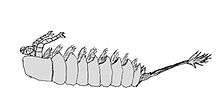Sarotrocercus
| Sarotrocercus | |
|---|---|
 | |
| Reconstruction of Sarotrocercus | |
| Scientific classification | |
| Kingdom: | Animalia |
| Phylum: | Arthropoda |
| Class: | incertae sedis |
| Genus: | †Sarotrocercus |
| Species: | †S. oblita |
| Binomial name | |
| Sarotrocercus oblita Whittington, 1981 | |
Sarotrocercus is a small Cambrian organism known from Burgess shale-type localities, reaching a centimetre or two in length (0.39–0.79 in).[1] It was pelagic and swam on its back. 28 specimens of Sarotrocercus are known from the Greater Phyllopod bed, where they comprise < 0.1% of the community.[2] It may lie in the arthropod crown group, and a recent study has revised some points of its original description.[3]
Morphology
It had a head shield followed by a body of nine segments and a caudal tip featuring a series of spines on the end. A pair of big eyes at the end of stalks emerged from the front of the shield. The head bore a pair of sturdy appendages that ended in a bidentate segment. Ten pairs of appendages with an elongated structure of comb-shaped, probably gill branches, are attached to the at the head segment (one pair) and the body segments (nine pairs).
Ecology
This small animal was a creature that swam freely on its back, moving perhaps through movements of the gills and the action of its long tail tuft.[4] The Burgess Shale contains few swimming organisms; the submarine landslides that buried organisms mainly smothered benthic and nektobenthic organisms.[5] Organisms living in the water column above this habitat were able to escape and above the 'danger zone' and are therefore much rarer. Among these are the notable Amiskwia, Nectocaris and Anomalocaris.
External links
- "Sarotrocercus oblita". Burgess Shale Fossil Gallery. Virtual Museum of Canada. 2011.
References
- ↑ Briggs, D.E.G.; Erwin, D.H.; Collier, F.J. (1995), Fossils of the Burgess Shale, Washington: Smithsonian Inst Press, ISBN 1-56098-659-X, OCLC 231793738
- ↑ Caron, Jean-Bernard; Jackson, Donald A. (October 2006). "Taphonomy of the Greater Phyllopod Bed community, Burgess Shale". PALAIOS. 21 (5): 451–65. doi:10.2110/palo.2003.P05-070R. JSTOR 20173022.
- ↑ Haug, J.T.; Maas, A.; Haug, C.; Waloszek, D. (2011). "Sarotrocercus oblitus - Small arthropod with great impact on the understanding of arthropod evolution?". Bulletin of Geosciences: 725–7??. doi:10.3140/bull.geosci.1283.
- ↑ Whittington, H.B. (1981). "Rare Arthropods from the Burgess Shale, Middle Cambrian, British Columbia". Philosophical Transactions of the Royal Society of London. Series B, Biological Sciences. The Royal Society. 292 (1060): 329–357. Bibcode:1981RSPTB.292..329W. doi:10.1098/rstb.1981.0033. JSTOR 2395674.
- ↑ Gabbott, S.E.; Zalasiewicz, J.; Collins, D. (2008). "Sedimentation of the Phyllopod Bed within the Cambrian Burgess Shale Formation of British Columbia". Journal of the Geological Society. 165: 307. Bibcode:2008JGSoc.165..307G. doi:10.1144/0016-76492007-023.